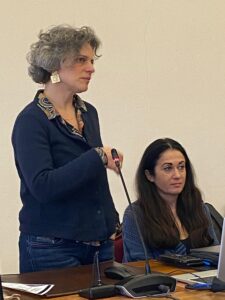
The final Transnational Partners meeting of the Cultural Heritage 2.0 project took place in Venice recently. The meeting was hosted by the project leaders Daniela Pavan, Innovation Designer and Sara Alba, Project Manager and held in the Aula Marino Berengo, at the historic Ca’Foscari University, overlooking the Grand Canal in Venice.
The meeting opened with welcoming remarks and reflections on the ambitions and achievements of the project from Prof. Monica Calcagno and Prof. Maria Lusiani of Ca’ Foscari University. The meeting then proceeded with a series of presentations from each of the project partners on the work they had done to date, the outputs created and how these had been received.
Madeleine Harbich, on behalf of the University of Vienna, stated that for her working on the Guidebook for Educators was a particular highlight. Daniela Pavan, of Ca’ Foscari University of Venice, responded that the feedback from their recent multiplier event was very positive with attendees particularly recognising the value of the guidebook and how it could be utilised across sectors and disciplines.
In her report, Marie Roloff, Leader of the Legal and Human Innovation Hub at the University of Copenhagen spoke about the Hackathon they had hosted as part of the project. By calling on Professors from different courses and disciplines to invite their students to participate they gathered a wide group of attendees. While the attendees had a core interest in a career in the broad cultural industry, it was very interesting to see how they interacted, working on problem-solving from their own perspective and according to their particular interests and experiences.
Daniela Pavan presented on behalf of the project leaders, Ca’ Foscari University of Venice. She spoke of how ambitious the plans of the project were, and how hard everyone worked to achieve them. However, delivering 50 OERSs in a very short timeframe left little time for reflection, or reviewing work to perhaps innovate within the project. She also spoke of how, as the project progressed it made sense to organically support additional activities outside of the core brief to ensure the success of the project. She spoke of the collaborative approach taken to ensure the delivery of high-quality outputs like the Competencies Gap Map, The Trend Report (within the Future Scenarios report) and the Train the Trainer facilitation.
 UIIN was represented at the meeting by Déspina Kortesidou. Her presentation covered the consortium’s plan, methodology, deliverables and impact in better understanding the cultural heritage status quo, as well as what the world would look like and need in 2035. Throughout work on PR1, the consortium pursued two tracks of research: “Research the Present” and provide HEI academic staff and educators with the knowledge, skills and resources that are relevant in the future, as well as “Scan the Future” (utilising Bespoke Manyone’s future design approach) and collaboratively design four future scenarios attempting to answer the question of what the world and the sector might look like in the future of 2035. The collaborative work led to completing the research phase and the complementary delivery of additional materials utilised by the subsequent PRs, like the Competencies Gap Map and the Trend report (within the Future Scenario book).
UIIN was represented at the meeting by Déspina Kortesidou. Her presentation covered the consortium’s plan, methodology, deliverables and impact in better understanding the cultural heritage status quo, as well as what the world would look like and need in 2035. Throughout work on PR1, the consortium pursued two tracks of research: “Research the Present” and provide HEI academic staff and educators with the knowledge, skills and resources that are relevant in the future, as well as “Scan the Future” (utilising Bespoke Manyone’s future design approach) and collaboratively design four future scenarios attempting to answer the question of what the world and the sector might look like in the future of 2035. The collaborative work led to completing the research phase and the complementary delivery of additional materials utilised by the subsequent PRs, like the Competencies Gap Map and the Trend report (within the Future Scenario book).
Momentum was responsible for project Dissemination. Denise Callan outlined the goals and targets set out at the start of the project, and that the project had been successful in achieving these. While the understandable delay in publishing Project results did prove a challenge in providing engaging content to disseminate for the first year of the project, there was a huge interest across the website, social media and ezine channels in the project. The project succeeded in strategically targeting its valuable outputs to the project target groups who responded enthusiastically with the number of project outputs downloaded currently exceeding the target set by.
Discussions took place in response to the presentations regarding the activities carried out by each partner to create the outputs and any challenges or valuable learnings they experienced during their work.
The consortium finally considered project sustainability and the potential for a new project. In an engaging interactive workshop facilitated by Kirsten van Dam of Bespoke Manyone. The consortium reflected on the results to be maintained and participated in a Workshop Sprint looking at the Why, What How and Who of the sustainability of the project then each partner made a concrete commitment to what they would contribute to ensure the future sustainability of the project.
It was unanimously agreed that this project required more time than it had been allocated to reach its full potential. Also, that the cultural heritage landscape has changed considerably since the end of the pandemic and with the emergence of new technologies such as AI. It was agreed that this project would benefit hugely from an additional or extended period of research to enable consideration of the impact of this new environment and the creation of new outputs and strategies to specifically address these.




